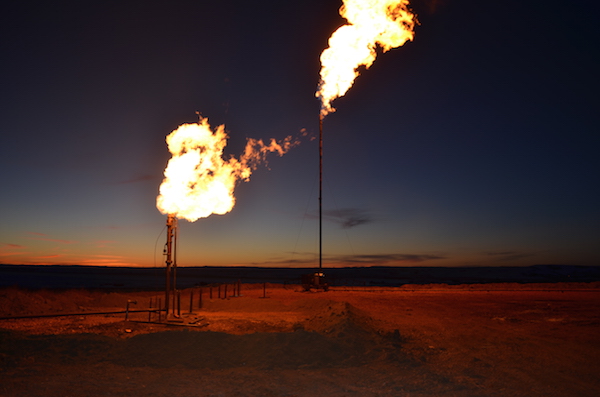Most policy experts agree that, along the long road to combating climate change and reducing greenhouse gas emissions, reducing wasted methane from oil and gas operations is “low-hanging fruit.”
In 2020 alone, wasted methane gas from oil and gas operations made up roughly one-third of all methane emissions from human activity. The obvious need to address this problem is why there are two proposed regulatory changes involving methane that could have major impacts on lowering greenhouse gas emissions from our country’s oil and gas sector. The rules — one from the Environmental Protection Agency and the other from the Bureau of Land Management — would seek to reduce methane waste, and their success is important for Wyoming’s environment and taxpayers alike.
Methane is the second-most significant greenhouse gas in terms of impact on global warming. It is responsible for approximately a quarter of the Earth’s warming since the Industrial Revolution and, when compared to carbon dioxide, it has roughly 80 times the global warming potential over a 20-year period (International Energy Agency). However, despite how methane’s potency, it cycles out of the atmosphere much quicker than carbon dioxide: This means methane emission reductions now can help lower greenhouse gas concentrations and buy time to make the necessary societal changes we need to achieve net zero emissions over the coming decades.
But putting aside the many climate and environmental benefits of reducing wasted methane, it also just makes sense as a cost-effective policy solution. Wasted methane, after all, is essentially natural gas that can be captured and brought to market. As a quick comparison, in 2019 alone, oil and gas operators wasted enough methane from venting and flaring (common ways operators manage methane waste) to power 2.1 million U.S. homes (Environmental Defense Fund).
In fact, the International Energy Agency estimates nearly 50 percent of wasted methane can be captured with no net cost to producers (IEA). This is because investments made in reducing methane emissions pay for themselves over the long term by keeping more natural gas in route to energy consumers and out of the atmosphere.
Which brings us to the new EPA and BLM methane rules — federal efforts the Wyoming Outdoor Council supports to help curb this wasteful practice. Last November, the EPA released new draft rules that would regulate wasted methane emissions for both new and existing sources for the first time. (Historically, in most cases, methane has only been regulated from “new and modified” emissions sources, and older “existing sources” of wasted methane have largely been left alone). The EPA rules would apply under the authority of the Clean Air Act, treating methane as an air pollutant. Importantly, the rules would regulate methane emissions from oil and gas facilities across all jurisdictions and land ownerships (including private, federal, and tribal lands) and, if they go into effect, could dramatically cut emissions and uniformly raise the bar for responsible energy development. The EPA’s rules are widely supported by both environmental and industry groups alike, because they are good for the environment, create an equal playing field for businesses by setting uniform standards, and establish regulatory certainty under which companies can predictably operate and plan.
Separately, the Department of the Interior is also considering a BLM methane waste rule that would apply more narrowly to oil and gas production on federal and tribal lands. The BLM’s rules take their authority from the waste prevention mandate in the Mineral Leasing Act of 1920. This mandate allows the Secretary of the Interior to “use all reasonable precautions to prevent waste of oil or gas developed on the land.” In states like Wyoming, where the majority of oil and gas development occurs on public lands, the application of this rule could help the public realize higher returns on the development of natural resources by charging royalties for wasted natural gas.
In 2018, the Outdoor Council estimated that Wyoming lost as much as $96 million worth of natural gas in a single year due to intentional flaring, venting, and careless leaks. This translates into roughly $16.1 million lost in annual royalty payments to the state. These are critical revenue streams that taxpayers and budget-strapped Wyoming communities deserve to see for the depletion of natural resources (WOC Oil and Gas Waste Report). And of course, the rule would provide further incentive for producers to keep methane in the pipeline and out of the atmosphere.
Both the BLM’s authority under its waste prevention mandate and the EPA’s authority under the Clean Air Act to regulate air pollutants are needed to address climate concerns and ensure that Wyomingites receive a fair value for the one-time use of their non-renewable resources. While some leading companies like Jonah Energy, Occidental, and Devon Energy are taking action to cut methane and support federal methane regulation, that simply isn’t enough. Most oil and gas operators are not doing frequent, thorough inspections for leaks and we need stronger state leadership to support these common sense federal rules that will benefit our environment and our pocketbooks.
Looking forward, both the EPA and BLM rules have procedural and administrative hurdles to clear before they go into effect, hopefully later this year. Our commitment is to continue tracking and advocating strong methane rules as well as keeping you informed of the opportunities to get these policies over the finish line in 2022. The long-term outlook of Wyoming’s climate, budget and residents depends on it.
John
Burrows
Energy and Climate Policy Director
Staff

